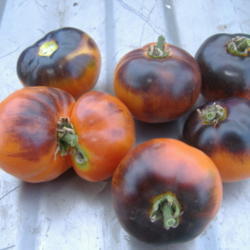
Summer is in full swing and the melon patch seems to be growing nightly! Cantaloupes and watermelons have set fruit. With enough water these babies will grow quickly to maturity. However, water isn't the only limiting factor to your melons producing bountifully this year. While cucumber beetles and flea beetles may have been attacking your young melon seedlings, now that the vines have grown, other pests are a greater concern. Be on the lookout for these pests in your melon patch.
Spider MitesSpider mites are very tiny, spider-like pests that attack a variety of plants such as melons. Most gardeners don't notice them until they see the webs spider mites form. Heavy feeding by spider mites causes stippling ? tiny holes ? in the leaves. If severe, their feeding can cause leaves to die. When their population is small, they and their damage are hardly noticeable. However, during periods of hot, dry, dusty summer weather, spider mite populations can explode.
To control spider mites, spray leaves with forceful jet of water from a hose to dislodge them.You can also try spraying insecticidal soap, hot pepper wax, or horticultural oil on the leaves.
Melon AphidsAphids are small insects that feed on melon leaves. They tend to attack once the melon vines starting running. Aphids are small sucking insects that come in colors ranging from light yellow to black. Heavy feeding can cause leaf dieback and reduction in melon quantity and quality. They also can spread diseases such as cucumber mosaic virus.
Like spider mites, aphid populations explode during periods of hot, dry weather. Encourage natural predators such as lady bugs by planting flowers around the melon patch and having a water source such as a water garden nearby. To control severe infestations, spray the undersides of the leaves with insecticidal soap or hot pepper wax, and place yellow colored pans filled with water in the melon patch to catch adults. The adult aphids are attracted to the color yellow.
Squash BugsAlthough their feeding is most severe on squashes and pumpkins, squash bugs do attack melons and can cause considerable damage to leaves. These flat-backed, brown bugs emerge in spring. They lay clusters of red-brown eggs on the underside of leaves which hatch into small brown nymphs that look similar to the adults. The young and adults feed on the leaves.
Squash bugs like to hide; you usually won't see them until you turn over an infested leaf. They will scurry away under other leaves and plant debris. You can use this secretive nature to trap them. Placing a piece of cardboard under the plants, check under it every few days, and crush any squash bugs congregated there. Control the adults early in the season to reduce problems when the population explodes in late summer. Control heavy infestations of nymphs with applications of neem oil. Clean up the site well in fall to remove places where adults can overwinter.
PicklewormsAlthough pickleworms will attack watermelons, most of their damage is seen on cantaloupes and other melons. The yellowish-white larvae feed on melon flowers, buds, and fruit. You probably won't notice them until you harvest and open the fruits. Pickleworm adults migrate to northern gardens from warmer regions and lay eggs on leaves in early summer. They hatch and feed on blossoms and developing fruit.
To control pickleworms, plant early maturing melon varieties such as 'Dallas' that you can harvest before the pickleworm population swells. Destroy rolled up melon leaves since they may contain pickleworm pupae inside.
For more on growing and caring for melons and watermelons, go to the Virtual Vegetable Guides at www.willhiteseed.com/store/asp/guides.asp
Question of the WeekCaterpillars on Tomatoes
Q. I found several large caterpillars munching on my tomatoes. What should I do to get rid of them?
A. It sounds like you're seeing tomato hornworms, which can grow to an alarming size (5 inches long)! Like most larvae in the butterfly and moth family, hornworms can be controlled by spraying Bt, (Bacillus thuringiensis). This organic control only affects only the larvae of butterflies and moths, not beneficial insects, animals, or pets. However, since Bt can take a few days to start working and tomato hornworms can do a lot of damage in a short time, just remove the ones you see by hand. Pick them off and place the hornworms in a pail of soapy water.
If you see a caterpillar with what looks like grains of white rice all over it, relocate it elsewhere in the garden rather than killing it. It has been parasitized by a braconid wasp and what you're seeing are the eggs. These small wasps are harmless to humans, but will help keep the hornworm population in check.
 Charlie Nardozzi is an award winning, nationally recognized garden writer, speaker, radio, and television personality. He has worked for more than 30 years bringing expert gardening information to home gardeners through radio, television, talks, tours, on-line, and the printed page. Charlie delights in making gardening information simple, easy, fun and accessible to everyone. He's the author of 6 books, has three radio shows in New England and a TV show. He leads Garden Tours around the world and consults with organizations and companies about gardening programs. See more about him at Gardening With Charlie.
Charlie Nardozzi is an award winning, nationally recognized garden writer, speaker, radio, and television personality. He has worked for more than 30 years bringing expert gardening information to home gardeners through radio, television, talks, tours, on-line, and the printed page. Charlie delights in making gardening information simple, easy, fun and accessible to everyone. He's the author of 6 books, has three radio shows in New England and a TV show. He leads Garden Tours around the world and consults with organizations and companies about gardening programs. See more about him at Gardening With Charlie.